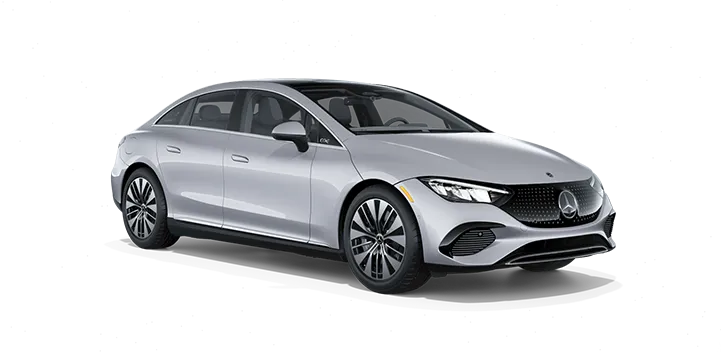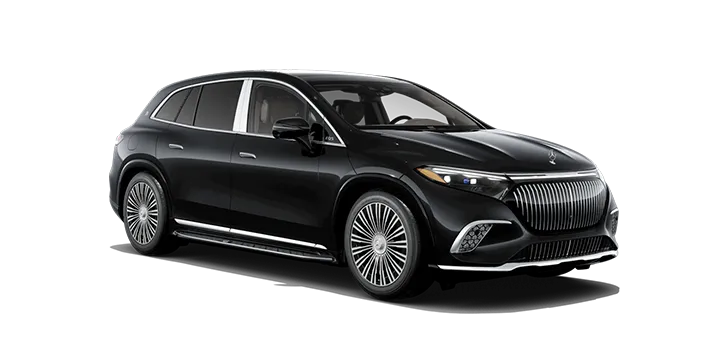Function of Active Brake Assist - Mercedes-Maybach S-Class Sedan March 2024 Z223 MBUX Owner's Manual
- Collision warning
- Autonomous braking function
- Situation-based brake force boosting
- Vehicles with Driving Assistance Package:Evasive Steering Assist
- Vehicles with Driving Assistance Package:Intersection start-off function
- Evasive Steering Assist (country-dependent)
Active Brake Assist consists of the following functions:
Active Brake Assist can help you to minimize the risk of a collision with vehicles, cyclists or pedestrians or to reduce the effects of such a collision.
If Active Brake Assist has detected a risk of collision, a warning tone will sound and the distance warning lamp will light up.
distance warning lamp will light up.
Indicator on theAssistancemenu on the driver display
On theAssistancemenu, an insufficient distance to the vehicle in front will be displayed in red. If you reduce the distance further, the vehicle in front will also be highlighted in red. When the system detects a risk of collision, red radar waves
will be displayed in red. If you reduce the distance further, the vehicle in front will also be highlighted in red. When the system detects a risk of collision, red radar waves will appear in front of your vehicle.
will appear in front of your vehicle.
Vehicles with PRE-SAFE®:depending on the country, an additional haptic warning will occur in the form of slight, repeated tensioning of the driver's seat belt.
- Vehicles with active ambient lighting:ifWarning Supportis activated, the Active Brake Assist warning will also be accompanied by ambient lighting (Adjusting the ambient lighting) .
If you do not react to the warning, autonomous braking may be initiated in critical situations.
In particularly critical situations, Active Brake Assist may also initiate autonomous braking directly. In this case, the warning tone and distance warning lamp will be activated at the same time as brake application.
distance warning lamp will be activated at the same time as brake application.
If you apply the brakes yourself in a critical situation or apply the brakes during autonomous braking, situation-dependent brake force boosting will occur. The brake pressure will increase up to maximum emergency braking if necessary.
If autonomous braking or situation-dependent brake force boosting has occurred, pop-up will appear on the driver display and then automatically disappear after a short time.
will appear on the driver display and then automatically disappear after a short time.
If the autonomous braking function or the situation-based braking assistance is triggered, additional preventive measures for occupant protection may also be initiated by PRE-SAFE®.
Active Brake Assist cannot always clearly identify objects and complex traffic situations.
- Give a warning or brake without reason
- Not give a warning or not brake
In such cases, Active Brake Assist might:
Active Brake Assist is only an aid. The driver is responsible for maintaining a sufficiently safe distance to the vehicle in front, vehicle speed and for braking in good time.
If Active Brake Assist is deactivated or the functions are restricted, e.g. owing to activation of another driving system, the Active Brake Assist warning lamp will appear on the driver display.
Active Brake Assist warning lamp will appear on the driver display.
- If the system is unavailable owing to dirty or damaged sensors or a malfunction, or if the functions are restricted, the Active Brake Assist
 warning lamp will appear on the driver display.
warning lamp will appear on the driver display.
- Also observe the system limits of Active Brake Assist.
The individual subfunctions are available in the following speed ranges:
Collision warning
The collision warning function can assist you in the following situations from approximately4 mph(7 km/h)with an intermittent warning tone and the distance warning lamp.
distance warning lamp.
Vehicles with PRE-SAFE®:depending on the country, an additional haptic warning will occur in the form of slight, repeated tensioning of the seat belt.
- at speeds up to approximately155 mph(250 km/h)when approaching moving vehicles ahead.
- at speeds up to approximately75 mph(120 km/h)when approaching crossing vehicles, pedestrians and cyclists.
- at speeds up to approximately62 mph(100 km/h)when approaching stationary vehicles.
- at speeds up to approximately50 mph(80 km/h)when approaching moving cyclists ahead.
- at speeds up to approximately43 mph(70 km/h)when approaching stationary pedestrians and cyclists.
Autonomous braking function
- at speeds up to approximately155 mph(250 km/h)when approaching moving vehicles ahead.
- at speeds up to approximately75 mph(120 km/h)when approaching crossing vehicles, pedestrians and cyclists.
- at speeds up to approximately62 mph(100 km/h)when approaching stationary vehicles.
- at speeds up to approximately50 mph(80 km/h)when approaching moving cyclists ahead.
- at speeds up to approximately43 mph(70 km/h)when approaching stationary pedestrians and cyclists.
The autonomous braking function can intervene from a speed of approximately4 mph(7 km/h):
Situation-based brake force boosting
- at speeds up to approximately155 mph(250 km/h)when approaching moving vehicles ahead.
- at speeds up to approximately75 mph(120 km/h)when approaching crossing vehicles, pedestrians and cyclists.
- at speeds up to approximately62 mph(100 km/h)when approaching stationary vehicles.
- at speeds up to approximately50 mph(80 km/h)when approaching moving cyclists ahead.
- at speeds up to approximately43 mph(70 km/h)when approaching stationary pedestrians and cyclists.
Situation-related brake force boosting may intervene from a speed of approximately4 mph(7 km/h):
Canceling brake application by Active Brake Assist
- Fully depressing the accelerator pedal or with kickdown.
- Releasing the brake pedal.
You can cancel brake application by Active Brake Assist at any time by:
- You steer to avoid an obstacle.
- There is no longer a risk of collision.
- An obstacle is no longer detected in front of your vehicle.
Active Brake Assist may cancel brake application when one of the following conditions is fulfilled:
Reaction to oncoming road users
- Reaction up to a speed of approximately62 mph(100 km/h)
- Warning of oncoming road users through warning tone and distance warning lamp

- Warning of oncoming road users through warning tone and distance warning lamp
- Autonomous braking application in order to reduce the severity of an accident
Active Brake Assist can also react to detected oncoming road users:
Intersection start-off function (vehicles with Driving Assistance Package only)
If a risk of collision with crossing traffic is detected when you are pulling away or driving at walking pace, three red arrows pointing in the direction of the crossing road user will light up one after the other on the driver display together with the distance warning lamp . If the situation is particularly critical, the arrows will begin to flash. A warning tone will also sound. If you do not react to the warning, acceleration may be restricted or autonomous braking may be initiated in critical situations. Autonomous braking can also prevent the vehicle from pulling away and hold it at a standstill. In particularly critical situations, Active Brake Assist may also initiate autonomous braking directly. In this case, the
. If the situation is particularly critical, the arrows will begin to flash. A warning tone will also sound. If you do not react to the warning, acceleration may be restricted or autonomous braking may be initiated in critical situations. Autonomous braking can also prevent the vehicle from pulling away and hold it at a standstill. In particularly critical situations, Active Brake Assist may also initiate autonomous braking directly. In this case, the distance warning lamp and warning tone will occur at the same time as brake application.
distance warning lamp and warning tone will occur at the same time as brake application.
If autonomous braking or situation-dependent brake force boosting has occurred, a pop-up will appear on the driver display and then automatically disappear after a short time.
If Active Brake Assist is set toLate, the purely visual warning level and restriction of acceleration will be deactivated. If the situation is particularly critical, it is still possible for a visual warning to be issued, a warning tone to be emitted and autonomous braking to be initiated.
Evasive Steering Assist
Evasive Steering Assist cannot always recognize objects or complex traffic situations clearly.
Moreover, the steering support provided by Evasive Steering Assist is not sufficient to avoid a collision.
- Detection of pedestrians, cyclists and vehicles.
- Help through additional steering assistance if it detects an evasive maneuver.
- Activation by an abrupt steering movement during an evasive maneuver.
- Assistance in taking evasive action and straightening the vehicle.
- Reaction from a speed of approximately13 mph(20 km/h)up to a speed of approximately68 mph(110 km/h).
Evasive Steering Assist has the following features:
You can cancel steering assistance by Evasive Steering Assist at any time by countersteering.
System limits
Full system performance will not be available for a short time after you switch on the vehicle or drive off. As long as the functions are restricted, the Active Brake Assist warning lamp may also be shown on the driver display. Depending on the environmental conditions, it may take a few minutes before full system performance is available.
Active Brake Assist warning lamp may also be shown on the driver display. Depending on the environmental conditions, it may take a few minutes before full system performance is available.
- In snow, rain, fog, heavy spray, glare, in direct sunlight or in greatly varying ambient light.
- If the sensors are dirty, fogged up, damaged or covered. (Information on vehicle sensors and cameras (vehicles with DRIVE PILOT)) (Information on vehicle sensors and cameras)
- If the sensors are impaired owing to interference from other radar sources, e.g. intense radar reflections in parking garages.
- If a loss of tire pressure or a defective tire has been detected and displayed.
- In complex traffic situations where objects cannot always be clearly identified.
- If pedestrians, cyclists or vehicles move quickly into the sensor detection range.
- If road users are hidden by other objects or are located close to other objects.
- If the typical outline of a pedestrian or cyclist cannot be distinguished from the background.
- If a pedestrian or cyclist is not detected as such, e.g. owing to special clothing or other objects.
- If the driver's seat belt is not fastened.
- On tight bends.
The system may be impaired or may not function in the following situations in particular:
You can watch an animation on this topic via the following link:










